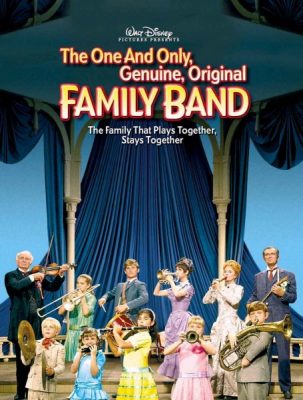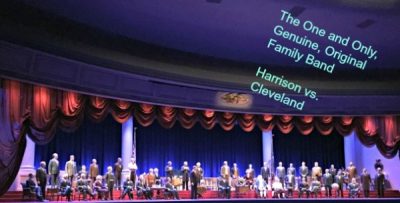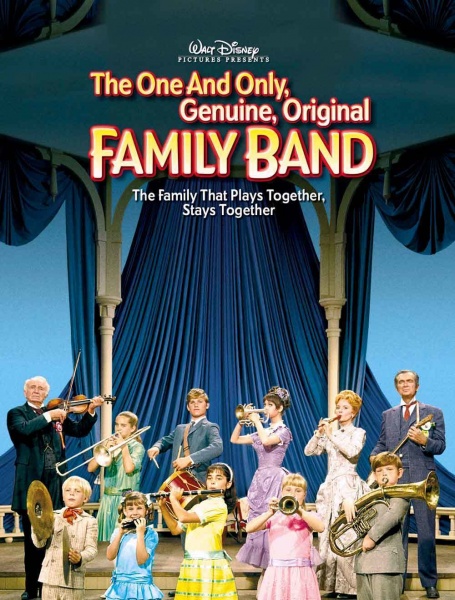
A live action musical comedy-drama based on Laura Bower Van Nuys’s 1961 memoir The Family Band: From the Missouri to the Black Hills, 1881-1900, Disney’s The One and Only, Genuine, Original Family Band was theatrically released on March 21, 1968. The film is 110 minutes in length.
Plot Summary
In a small midwestern town in the spring of 1888, the Bower family, a large group that includes Grandpa Bower (Walter Brennan), his son Calvin Bower (Buddy Ebsen), his daughter-in-law Katie Bower (Janet Blair), his young-adult granddaughter Alice Bower (Lesley Ann Warren), and his seven younger grandchildren (Kurt Russell, Bobby Riha, Jon Walmsley, Smith Wordes, Heidi Rook, Debbie Smith, and Pamelyn Ferdin), prepares an elaborate musical number, “Let’s Put It Over With Grover,” which Grandpa Bower hopes will be accepted by the Democratic National Committee for performance at the 1888 Democratic National Convention in St. Louis. To the family’s joy, the song is indeed accepted.
The family band is superficially harmonious, but beneath the surface, the group is badly fractured: although Grandpa Bower, a Confederate veteran of the Civil War, is an outspoken Democrat, his son and daughter-in-law are Republicans, albeit not especially vocal partisans. This political division becomes grave when the family, enticed by a lecture from Alice’s Republican boyfriend Joe Carder (John Davidson), decides to skip the Democratic Convention and instead move to a staunchly-Republican town in the Dakota Territory. With the 1888 presidential election between incumbent Democratic President [Stephen] Grover Cleveland and Republican challenger Benjamin Harrison on the horizon and the issue of Dakota statehood tied to the election results, Grandpa Bower cannot help but fight with his Republican neighbors, a feud that threatens both Alice’s teaching job and her relationship with Carder. Can these homesteaders put politics aside to live in harmony?
Production
Walt Disney initially intended Original Family Band to be a two-part television special, presumably to be broadcast on his weekly NBC-TV program, “Walt Disney’s Wonderful World of Color.” Disney’s popular Davy Crockett films of the 1950s, Davy Crockett, King of the Wild Frontier (1955) and Davy Crockett and the River Pirates (1956), had originated in this format, first airing in separate installments on Disney’s weekly program—at the time broadcast on ABC-TV as “Disneyland”—before being amalgamated into two feature films. Eventually, however, Walt Disney changed Original Family Band into a theatrical movie project. (1)
The screenplay for Original Family Band was written by Lowell S. Hawley based on Van Nuys’s memoir. As recalled years later by Richard Sherman, who along with his brother Robert Sherman composed the music for this and many other classic Disney films, “We [Richard and Robert Sherman] took Lowell Hawley’s script and worked with Lowell on how we could work songs into it. So, we’d sometimes remove dialogue scenes and make them happen musically, or we’d expand something, and, before long, we had a musical. Walt [Disney] really loved The Happiest Millionaire [1967], and we had done [Mary] Poppins [1964] a few years before that, and so he was on this musical kick. He wanted to do more musicals.” (2)
The Sherman Brothers’ development of an extended opening number for the film was essential to the project’s evolution. Deeming the film’s working title, “The Family Band,” mundane, the Sherman Brothers composed an extravagant tune, “The One and Only, Genuine, Original Family Band,” which Richard Sherman felt gave the movie “pizzazz.” Sadly, shortly before the song was slated to be recorded with a full orchestra, Walt Disney passed away. Years later, Richard Sherman recalled, “Bob [Robert Sherman] and I felt very strongly about this project, this particular picture because of the fact that it was his [Walt Disney’s] last creative input picture; he came up with wonderful creative suggestions. We’d bounce everything off of Walt. So this is truly Walt’s picture, even though he had died and it didn’t get released ‘till like a year-and-a-half after his death.” (3)
In a 2004 interview, Richard Sherman and Lesley Ann Warren recalled that Kurt Russell disliked the singing and dancing aspects of Original Family Band but eagerly relented when told “You’re an actor, so you are going to act like you can sing and dance.” (4)
Unbeknownst to anyone at the time of Original Family Band’s production, the script’s call for a “Giggly Girl to make [the] leading lady [Alice Bower] jealous [during the rendition of the song “West o’ the Wide Missouri”]” would have significant real-life ramifications. Hugh Lambert, a choreographer for Original Family Band, recommended a young woman named Goldie Hawn, who Lambert knew from NBC-TV’s “Rowan & Martin’s Laugh-In,” for the part. Hawn met Kurt Russell for the first time on the set of Original Family Band, and the two would marry in 1983. (5)
Election of 1888
In the United States Presidential Election of 1888, Republican candidate Benjamin Harrison of Indiana, along with Harrison’s Vice-Presidential running mate, Levi P. Morton of New York, defeated incumbent Democratic President Grover Cleveland of New York, along with Cleveland’s running mate, Allen G. Thurman of Ohio. Harrison became the third man to win the presidency despite losing at least a plurality of the popular vote, following John Quincy Adams in 1824 and Rutherford B. Hayes in 1876. (6)
Though he ran with Cleveland, Thurman was not the incumbent vice president, the office having been vacant since the death of Vice President Thomas A. Hendricks on November 25, 1885; prior to the adoption of the Twenty-Fifth Constitutional Amendment in 1967, the vice presidency remained vacant until the next presidential election if the incumbent died in office. Thurman, at seventy-five years-of-age, was the oldest vice-presidential nominee on a major-party ticket at the time, and he remains second in this regard only to Henry G. Davis, who was eighty-one years old when he ran as the Democratic vice-presidential candidate on the losing ticket with Alton B. Parker in 1904.
The primary substantive issue of the 1888 campaign was the tariff, the federal government’s main revenue source prior to the income tax, which was rendered constitutional by the Sixteenth Amendment (1913). (7) Tariffs had served one of two purposes since the First Congress in 1789: they could be used to amass revenue, thus limiting the need for internal taxes, or they could be used to protect domestic industry, increasing the prices of foreign manufactured goods while also creating more jobs and keeping money within the country. (8) Prior to the 1888 election, the Cleveland administration, albeit on extremely ambiguous terms, advocated tariff reduction, primarily to decrease an excessive treasury surplus that threatened deflation and government extravagance but also to appeal to Americans who were angered by the increasingly corporate environment of the Gilded Age. (9) Harrison and the Republicans, conversely, advocated retaining a high tariff while, if necessary, reducing internal duties, a position that still appealed to industry as well as to farmers, who had some of their products protected. Furthermore, Republicans of all classes throughout the North, both east and west, were patriotically attracted to the American nature of the protective system against European free trade, and the Democrats still retained stigma as the party of secession. (10)
The Democratic National Convention, which met at the Exposition Building in St. Louis from June 5-7, 1888, was a rather mundane affair superficially. Contention arose behind the scenes over the nature of the party’s tariff-reform plank, but harmony dominated on the floor. With Cleveland’s political enemies from New York absent from the proceedings, the president was unanimously re-nominated, and, though Thurman was new to the ticket, party leaders had largely agreed on his merits prior to the convention. Thus, Thurman was overwhelmingly nominated for vice president on the first ballot. (11) The Republican National Convention, which met in Chicago between June 19 and 25, 1888, featured more contention over the selection of a nominee, Senator John Sherman of Ohio being the frontrunner before Harrison was chosen on the eighth ballot. (12)
North Dakota and South Dakota, previously the single Dakota Territory, along with Montana and Washington, were admitted to the union via the Enabling Act of 1889, signed by Cleveland and carried out under Harrison. Residents of these territories were angry that partisan wrangling in Congress over the previous half-decade had thwarted their statehood bids, which were crucial to attaining full self-government. Indeed, both major party platforms of 1888 blamed the opposition for the delays. (13) Residents of the Dakota Territory largely supported Harrison during the election because of anger over President Cleveland’s appointment of a New York judge as territorial governor, anger over the president’s harsh policies concerning the use of federal land, and anger over the Democratic House of Representatives’ refusal to admit Dakota as two states rather than one. (14)
Music
With nine lyrical songs— “The One and Only, Genuine, Original Family Band,” “The Happiest Girl Alive,” “Let’s Put It Over With Grover,” “Ten Feet Off the Ground,” “Dakota,” “‘Bout Time,” “West o’ the Wide Missouri,” “Drummin’ Drummin’ Drummin,’” and “Oh, Benjamin Harrison”—The One and Only, Genuine, Original Family Band is unequivocally a musical. Dave Smith, chief archivist emeritus of the Walt Disney Archives, lists Original Family Band as one of Disney’s live action musicals, along with Song of the South (1946), So Dear to My Heart (1949), Babes in Toyland (1961), Summer Magic (1963), Mary Poppins, The Happiest Millionaire, Bedknobs and Broomsticks (1971), and Pete’s Dragon (1977). (15)
Richard and Robert Sherman, who wrote all the music for Original Family Band and who contributed to the soundtracks of The Parent Trap (1961), The Sword in the Stone (1963), Summer Magic, Mary Poppins, The Gnome-Mobile (1967), The Jungle Book (1967), The Aristocats (1970), and numerous other Disney flicks, were named Disney Legends in 1990.
Music is crucial to the harmony of the Bower family—the family’s general love of music transcends the political differences among the unit’s three generations. The unifying effect of music in this regard is expressed in the song “Ten Feet Off the Ground.”
On the whole, I think Original Family Band is one of the Sherman Brothers’ weaker efforts, although the quantity of songs establishes a fun atmosphere and the soundtrack did grow on me when I watched the movie a second time. The movie’s best song is the title number, which triumphantly commences the film and will linger in your head throughout. Additionally, there is something inspiring about “Dakota”; “West of the Wide Missouri” combines energetic dancing with a jolly tune; and history aficionados will enjoy the substance of the two campaign songs, “Let’s Put It Over With Grover” and “Oh, Benjamin Harrison.”
Relationship to Other Disney Films
Walter Brennan had previously co-starred in Those Calloways (1965) and The Gnome-Mobile for Disney.
Buddy Ebsen, who was named a Disney Legend in 1993, had previously co-starred in Davy Crockett, King of the Wild Frontier and Davy Crockett and the River Pirates for Disney.
John Davidson and Lesley Ann Warren had previously co-starred in The Happiest Millionaire for Disney.
Wally Cox, who portrayed the schoolboard president, Mr. Wampler, in Original Family Band, subsequently appeared in The Barefoot Executive (1971) for Disney.
Original Family Band was the second of fifteen Disney films to feature Kurt Russell, who was named a Disney Legend in 1998. Russell had previously appeared in Follow Me, Boys! (1966) for Disney, and he subsequently contributed to The Horse in the Gray Flannel Suit (1968), The Computer Wore Tennis Shoes (1969), The Barefoot Executive, Now You See Him, Now You Don’t (1972), Charley and the Angel (1973), Superdad (1973), The Strongest Man in the World (1975), The Fox and the Hound (1981), Captain Ron (1992), Tombstone (1993), Miracle (2004), Sky High (2005), and Guardians of the Galaxy Vol. 2 (2017) for the studio.
In the Parks
The Sherman Brothers wrote the catchy soundtracks for “It’s a Small World,” “Walt Disney’s Enchanted Tiki Room,” “Walt Disney’s Carousel of Progress,” and “Journey Into Imagination With Figment.” At Walt Disney World, the former three attractions are situated at the Magic Kingdom, and the last attraction is located at Epcot.
Grover Cleveland and Benjamin Harrison are both included in the presidential roll in the Magic Kingdom’s “Hall of Presidents” attraction. Cleveland is only included once in the roll call, before Harrison, although Cleveland served a second non-consecutive term following Harrison, who Cleveland defeated in the 1892 election.

Outside the Hall of Presidents in the Magic Kingdom’s Liberty Square section, the Muppets present two amusing patriotic shows, one parodying Paul Revere’s famous midnight ride and the other parodying the signing of the Declaration of Independence. In Original Family Band, Revere is mentioned along with other American Revolution-era heroes, including George Washington, Patrick Henry, and Nathan Hale, in “Let’s Put It Over With Grover.” Additionally, although he is not portrayed by the Muppets, Benjamin Harrison’s great-grandfather and namesake signed the Declaration of Independence as one of Virginia’s representatives to the Second Continental Congress.
Abraham Lincoln, who is mentioned in “Let’s Get It Over With Grover,” speaks in “The Hall of Presidents” and Disneyland Park’s “The Disneyland Story presenting Great Moments with Mr. Lincoln.”
Overall
With a plethora of songs and a surprisingly-engaging plot, The One and Only, Genuine, Original Family Band will keep you entertained.
Notes
1) “The Family Band Album” [DVD] (2004). United States: Disney. Approximately 13-minute segment featured on 2004 DVD release of The One and Only, Genuine, Original Family Band, 0:07 [minutes and seconds into segment].
2) Ibid., 0:10-0:39.
3) Ibid., After 10:03.
4) Ibid., 1:47-2:17.
5) Ibid., 3:54-5:02.
6) Robert F. Wesser, “Election of 1888,” in Fred L. Israel, Arthur M. Schlesinger, and Gil Troy, eds. History of American Presidential Elections, 1789-2008 (New York: Facts on File, Inc, 2012) eBook Collection (EBSCOhost), EBSCOhost (accessed January 14, 2018), 676-711.
7) Ibid., 684.
8) Stanley Elkins and Eric McKitrick, The Age of Federalism: The Early American Republic, 1788-1800 (New York: Oxford University Press, 1993), 65-67; Norman K. Risjord, The Old Republicans: Southern Conservatism in the Age of Jefferson (New York: Columbia University Press, 1965), 208-10.
9) Wesser, “Election of 1888,” passim.
10) Ibid.
11) Ibid., 676-81, 686-88.
12) Ibid., 690-95.
13) “Republican Party Platform of 1888,” The American Presidency Project, accessed January 14, 2018, http://www.presidency.ucsb.edu/ws/index.php?pid=29627; “1888 Democratic Party Platform,” The American Presidency Project, accessed January 14, 2018, http://www.presidency.ucsb.edu/ws/index.php?pid=29584; Robert Edwin Albright, “Politics and Public Opinion in the Western Statehood Movement of the 1880’s,” Pacific Historical Review, 3, no. 3 (September 1934): 296-306.
14) Ibid.; Kenneth N. Owens, “The Prizes of Statehood,” The Magazine of Western History, 37, no. 4 (Autumn 1987): 2-9, esp. 7-8.
15) Dave Smith, Disney Trivia from the Vault: Secrets Revealed and Questions Answered (New York: Disney Editions, 2012), 154.
What do you think of The One and Only, Genuine, Original Family Band? Let me know in the comments!
Sponsored Ad: Would you like to help support The Mouse For Less website in continuing their mission of being THE Disney vacation planning resource? You can do so by purchasing The One and Only, Genuine, Original Family Band from our Affiliate Link through Amazon. Thanks so much for your support!
Incoming search terms:
- https://www themouseforless com/blog_world/movie-review-the-one-and-only-genuine-original-family-band/

